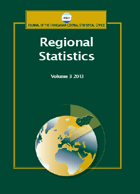High demand for local area level statistics –
How do National Statistical Institutes respond?
High demand for local area level statistics –
How do National Statistical Institutes respond?
Author(s): Marie HaldorsonSubject(s): Social Sciences, Economy, Geography, Regional studies
Published by: Központi Statisztikai Hivatal
Keywords: statistical-geospatial integration; statistics at local area level; UN 2030 Agenda for sustainable development; Global Statistical Geospatial Framework (GSGF)
Summary/Abstract: Linking people to place is becoming increasingly important, not least because of the 2030 Agenda for sustainable development. Enhancing traditional statistics at the regional level with those at the local area level enriches the way National Statistical Institutes provide information to society. To provide such statistics at local level in a timely manner, the production of statistics needs to be modernised and based on various data sources, such as administrative registers and geospatial information. The United Nations has recognised the importance of statistical-geospatial integration bycreating an Expert Group under the UN Global Geospatial Information Management initiative. The European Statistical System has also paved the way for such an integration by funding the GEOSTAT projects. For National Statistical Institutes looking to improve their capability to produce statistics at the local level, the Global Statistical Geospatial Framework is a starting point that describes the requirements that need to be fulfilled. For guidance on how to start with amore bottom-up approach, the GEOSTAT 2 project has developed key actions aligned with the Generic Statistical Business Process Model. Statistics Sweden’s capability assessment might also provide some inspiration.
Journal: Regional Statistics
- Issue Year: 9/2019
- Issue No: 01
- Page Range: 168-186
- Page Count: 19
- Language: English

